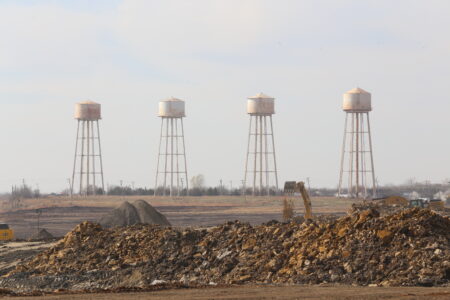As EPA raises concerns about ‘forever chemicals,’ one Kansas community is trying a new approach to wastewater sludge

photo by: Shawn Valverde/Special to the Journal-World
A tractor applies biosolids to a field next to the Wakarusa Wastewater Treatment Plant on February 22, 2025.
In Lawrence, officials don’t think there’s much risk of harmful chemicals getting into the nutrient-rich sludge that’s produced in the city’s wastewater treatment plants. But at least one other city in northeast Kansas, Olathe, is interested in taking extra precautions.
The sludge, or biosolids, is frequently applied to farmland in Kansas to enrich the soil, and Kansas does not have any regulations on this practice aside from what is established by the Environmental Protection Agency. But environmentalists — and the EPA itself — have recently raised concerns about biosolids being contaminated with per- and polyfluoroalkyl substances, also known as PFAS or “forever chemicals,” which normal wastewater treatments can’t remove.
Some other states are implementing bans on using biosolids as fertilizer. In 2022, Maine became the first state to ban it after PFAS contaminated crops and water on over 50 farms where sludge had been spread. Beginning in October of last year, Connecticut followed suit.
Michael Leos, a spokesperson with Lawrence’s Municipal Services and Operations Department, told the Journal-World via email that the city is working on monitoring future regulations associated with PFAS in biosolids. He said the city isn’t expecting to see anything concerning in its own biosolids program.
“We do not anticipate seeing levels in our biosolids that will be of concern since there are no known PFAS sources in Lawrence,” Leos said in the email.
In Olathe, however, city officials are trying something different. They’re exploring a new method that will use high pressures and temperatures to process the waste in a different way — and possibly recover other valuable substances, like useful minerals, from it.
• • •
For decades, the EPA has encouraged the use of sludge from treated wastewater as an inexpensive fertilizer, with no limits on how much PFAS it can contain. But recently, there have been signs that the EPA is shifting its course.
In 1987, the Water Quality Act required the EPA to create a program to reduce environmental risks from sewage sludge and promote its beneficial reuse. This is known as the Part 503 rule, and it includes standards for pollutant concentration and pathogen density along with requirements for monitoring. It’s this rule that governs the use of sewage sludge on farm fields in Kansas.
But on Jan. 14, the EPA issued its first warning that “forever chemicals” in sewage sludge used as fertilizer may threaten human health, saying that in some cases they could exceed the EPA’s safety thresholds “sometimes by several orders of magnitude.”
The EPA released a draft sewage sludge risk assessment for public comment, and it raises concerns about two types of PFAS — perfluorooctanoic acid, or PFOA, and perfluorooctane sulfonic acid, or PFOS. The assessment reflects the agency’s latest understanding of the potential risks these chemicals pose when sewage sludge is applied to land, incinerated or put in landfills — the three major ways that these waste products are disposed of.
EPA’s initial analysis indicates that biosolids with PFOA or PFOS do not significantly impact the nation’s food supply. The U.S. Department of Agriculture and Food and Drug Administration are monitoring PFAS in food and taking protective actions for affected products, a press release from the EPA said.
But the EPA also acknowledges that certain areas may have higher PFOA or PFOS levels if contaminated sludge was used, and it says it will work with affected farms and agencies to assess risks. Households most at risk are those living on or near sites where contaminated biosolids are applied to land or disposed of, and those who use products from contaminated sources, such as beef or milk from family farms exposed to PFAS through sewage sludge.
Once the assessment is finalized, it will help the EPA and its partners understand the public health impact of forever chemicals in biosolids and inform any future actions that can help reduce the risk of exposure.
• • •
What if the sludge could be disposed of in a different way — one that might still yield useful byproducts with less risk? That’s what the City of Olathe is exploring at its Cedar Creek Wastewater Treatment Plant. It will be using a new technology to apply high pressure and temperature to break down waste, reduce environmental impact and potentially recycle valuable minerals for other uses.
“The best part about it is our city management and our city council is completely supporting this opportunity to test this new technology and kind of allow us to get ahead of the (any upcoming) regulations on biosolids,” said Sabrina Parker, water and sewer manager with the City of Olathe.
Parker said the city previously did an assessment of its biosolids operations in 2023, and it analyzed different technologies and methods to find a better method to dispose of Olathe biosolids from Cedar Creek.
Currently, the plant sends all of its biosolids to a landfill. But the city’s pilot project, which is in the early design phases, will use high pressure and heat to reduce the biosolids so there’s very little left.
The proposed disposal method would involve pressurizing the waste to very high levels — 3,200 psi — and heating it to 705 degrees Fahrenheit. At the high pressure and temperature, the bonds between molecules in the waste will start to break down, and this will allow for the removal of pharmaceuticals, PFAS and other chemicals.
Parker said 90% to 95% of the biosolids are expected to be reduced through this process. It will also produce a byproduct of a “mineral slurry,” in which elements such as phosphorus, nitrogen and copper could be dissolved out. Parker said right now, the project team is calling it a “slurry” because until they test the waste stream, it’s difficult to know what elements are present.
Instead of the sludge itself being used as fertilizer, the slurry could provide substances for other uses, like giving farmers phosphorus for their fields.
The reason this is a pilot project is because the city will be testing all of its parameters to make sure it’s a good match for the waste stream. Parker said every facility operates differently.
“One of the biggest challenges is not knowing and being one of the first units to be fully installed (at a wastewater treatment plant),” Parker said. She said there have been smaller projects implemented to destroy PFAS chemicals, but that it hasn’t been implemented in a plant of this size.
Parker estimated that it will take 11 months for the unit to be constructed after the city signs a purchase order. She said the team is hoping to have it fully operational, or at least in the pilot testing phase, by next June.
• • •
Here in Lawrence, the city’s wastewater processes still produce biosolids for farm fields, and the city doesn’t have any major concerns about PFAS contamination, as Leos, the Municipal Services and Operations spokesman, said.
But that doesn’t mean the city isn’t monitoring for potential problems or changes in the regulatory environment.
Leos said the city routinely gathers operational and research data to optimize its treatment processes or to get a better understanding of things that may be regulated in the future.
“We are currently researching PFAS in our biosolids with the first recently approved testing method for PFAS in wastewater and biosolids and through an ongoing Residual Study that City recently contracted,” Leos said.
That study will conduct an assessment on the biosolids management program, and it could include exploring new technologies for how the waste is handled. It’s expected to generate a report later this year.







